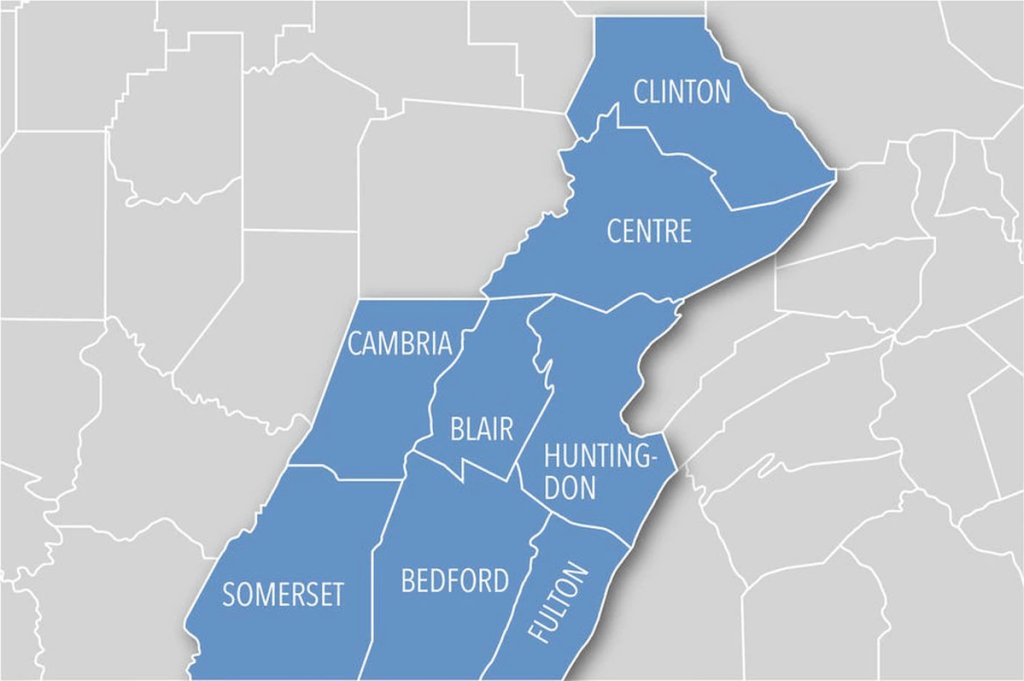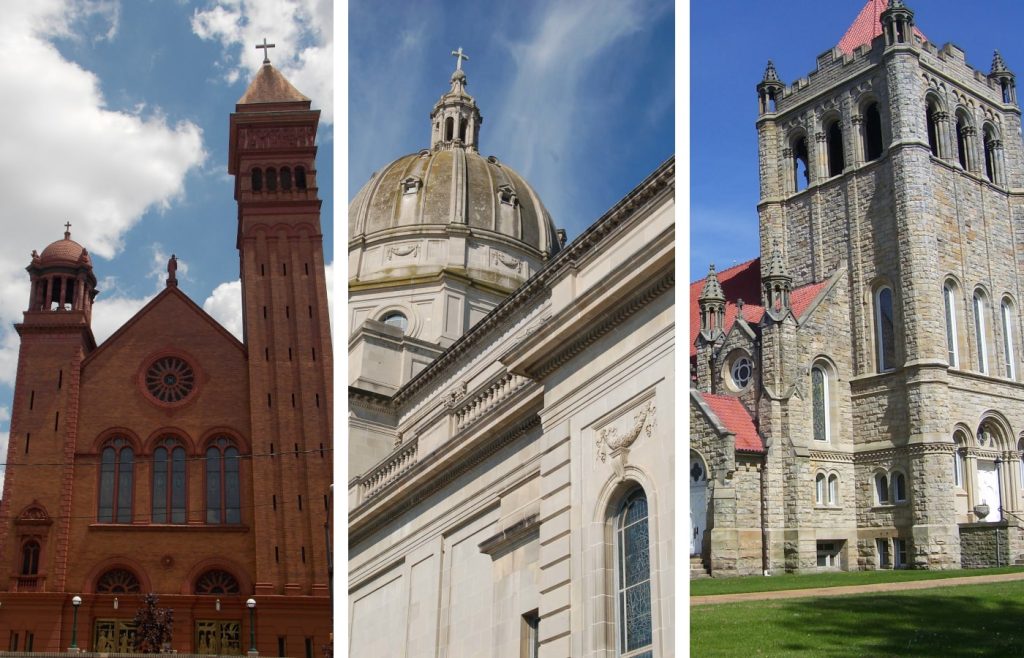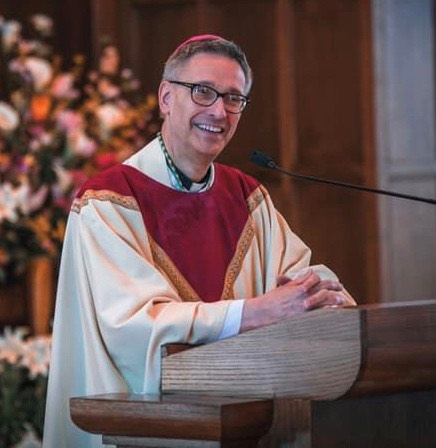Diocesan History
The Diocese of Altoona was established in 1901, with the Most Reverend Eugene A. Garvey as the first Bishop. It was renamed the Diocese of Altoona-Johnstown in 1957.
Eight counties comprise the Diocese of Altoona-Johnstown: Bedford, Blair, Cambria, Centre, Clinton, Fulton, Huntingdon, and Somerset. The diocese is divided into five deaneries, or geographic administrative units. As of 2021, the total Catholic population of the eight-county area was 69,721.
The Diocese of Altoona-Johnstown is home to 87 parishes, which are served by both diocesan priests and priests from various religious communities, including the Third Order Regular Franciscans, the Conventual Franciscans, the Capuchin Franciscans, and Order of Saint Benedict.
Communities of nuns and sisters have served locally since 1848, and today engage in a variety of ministries including Catholic education, healthcare, social services, and contemplative lives of prayer.
There are two Cathedrals in the diocese: the Cathedral of the Blessed Sacrament in Altoona, and Saint John Gualbert Cathedral in Johnstown – as well as the Basilica of Saint Michael the Archangel in Loretto, which Pope John Paul II named a Minor Basilica in 1996.
Additionally, the diocese has three shrines: the Prince Gallitzin Chapel House/Our Lady of the Alleghenies Shrine in Loretto, Saint Joseph Mission Church at Hart’s Sleeping Place in Carrolltown, and Immaculate Conception Shrine in Bitumen.
Since its establishment in 1901, eight Bishops have led the Diocese of Altoona-Johnstown. The current Bishop, the Most Reverend Mark L. Bartchak, was ordained a Bishop on April 19, 2011 at the Cathedral of the Blessed Sacrament in Altoona, and installed as the eighth Bishop of the diocese on that day.
The Diocesan Pastoral Center, located in Altoona, serves as the administrative offices to the Bishop and the majority of his staff. Catholic Charities offices are located in Altoona and Johnstown. The Lay Ecclesial Ministry and Permanent Deaconate Offices are located in Johnstown.
Several diocesan councils serve as consultative bodies to the Bishop, including the Presbyteral Council, the Priests’ Personnel Board, and the Finance Council. The groups meet on a regular basis throughout the year.
The Diocese of Altoona-Johnstown boasts a proud education tradition with 13 Catholic elementary schools and four independent Catholic high schools. Religious Education programs at each parish serve students not enrolled in Catholic schools. There are two Catholic colleges/universities located in the diocese, and diocesan-sponsored Catholic Campus Ministry at all colleges/universities in the diocese.
The diocese also has an active television ministry with production facilities at the Diocesan Pastoral Center and at Saint John Gualbert Cathedral. The ministry includes the Production of Proclaim!, a weekly 30-minute program featuring diocesan news and the live broadcast of the 11:00 AM Mass on WATM ABC 23 each Sunday morning – one of the few live, hour-long Mass broadcasts in the country.
Chronology of the Diocese
1754
Fort Duquesne is founded.
December 22, 1770
Demetrius Gallitzin is born at the Hague, Netherlands.
1785
Captain Michael McGuire settles his family at McGuire’s Settlement, near what became Loretto.
1787
Gallitzin is converted from the Russian Orthodox Church to Roman Catholicism.
Patrick Cassidy Settles in Newry.
August 18, 1792
Gallitzin sails to the United States from Rotterdam.
November 5, 1792
Demetrius Gallitzin enters the Sulpician Seminary in Baltimore under the name Augustine Schmet (Smith).
1794
First Settlement is established at Johnstown.
March 18, 1795
Gallitzin is ordained by Bishop John Carroll. He is posted to the Conewago Mission in Pennsylvania.
While there, he answers a sick call to McGuire’s Settlement.
December 25, 1799
Bishop Carroll appoints Father Smith (Gallitzin) as Pastor of McGuire’s Settlement.
Father Smith (Gallitzin) celebrates Midnight Mass in the newly constructed Saint Michael’s Church.
1800
Baptism of the first infant born in McGuire’s Settlement – Joseph Bradley, son of Charles and Mary Bradley.
Father Smith (Gallitzin) establishes the community of Loretto, in honor of the Shrine of Our Lady in Loreto, Italy.
1802
Father Smith (Gallitzin) becomes a naturalized citizen of the United States.
1808
Bishop John Carroll is proclaimed the first Archbishop of Baltimore by Pius VII.
The Diocese of Philadelphia is established, with Michael Egan as its first Bishop.
1809
Father Smith (Gallitzin) receives legal permission to resume the use of his real name – Rev. Demetrius Gallitzin.
1811
Bishop Egan visits Loretto and confirms 198 of Gallitzin’s parishioners.
1815
Archbishop John Carroll, Archbishop of Baltimore and architect of the Catholic Church in the United States, dies.
1816
Gallitzin publishes his Defense of Catholic Principles.
Saint Patrick Church in Newry is constructed and becomes the second parish in the area.
1817
Gallitzin constructs a second, large-frame church at Loretto.
Gallitzin’s sister, Marianne, marries and so deprives her brother of his rightful inheritance.
1819
Gallitzin publishes An Appeal to the Protestant Public in reply to Vindication of the Doctrines of the Reformation.
1820
Gallitzin publishes A Letter to a Protestant Friend on the Holy Scriptures.
1823
Gallitzin is appointed Vicar General of Western Pennsylvania.
1829
Rev. Patrick Rafferty is appointed Assistant Pastor to Gallitzin.
1832
Gallitzin oversees construction of a larger house and adjoining chapel, the present Prince Gallitzin Chapel House.
1834
Gallitzin is thrown from his horse and suffers an injury to his leg, complicated by a hernia from which he never recovers.
Rev. Peter Lemcke is appointed assistant.
1835
Johnstown’s first parish – Saint John Gualbert – is established.
1836
Gallitzin publishes The Bible: Truth and Charity.
May 6, 1840
Rev. Demetrius Gallitzin dies.
He is buried three days later on May 9.
1841
Saint Mary Parish is founded in Hollidaysburg.
1843
Pope Gregory XVI creates the Diocese of Pittsburgh.
1847
Gallitzin’s remains are exhumed and moved to a vault outside the church entrance.
Franciscan friars arrive at Loretto from Ireland and establish Saint Francis School for Boys.
1848
Sisters of Mercy arrive in Loretto.
1849
The city of Altoona is founded.
1853
Sisters of Mercy establish the Saint Aloysius School for Girls.
The city of Altoona receives its first resident pastor, Father John Tuigg.
1854
The third church is built at Loretto, constructed of brick. It is dedicated by Saint John Neumann, Bishop of Philadelphia.
1860
Immaculate Conception Church – “Old Saint Mary’s” – in Altoona is built for German Catholics.
1869
Sisters of Saint Joseph establish a foundation at Ebensburg.
1870
At the invitation of Father Tuigg, four Sisters of Charity arrive in Altoona from Cincinnati to establish a community in Altoona and teach in his school.
1876-77
The diocese of Allegheny has its brief life.
1889
The Johnstown Flood brings massive devastation and death.
Saint John Gualbert Church is destroyed in a fire.
1899
Centennial of the founding of Loretto.
Archbishop John Ireland of St. Paul, Minnesota dedicates the enlarged and expanded tomb of Rev. Gallitzin.
Charles Schwab donates funds and makes possible the construction of the fourth church at Loretto – the present Saint Michael’s.
1901
The present Basilica of Saint Michael the Archangel is completed.
The Diocese of Altoona is established by Pope Leo XIII. Bishop Eugene Garvey is named its first Bishop.
1909
Saint John’s orphanage is opened.
1910
Mercy Hospital in Johnstown is opened by the Sisters of Mercy.
1912
Bishop Garvey opens an ecclesiastical seminary at Loretto.
1917
Saint Mary’s Orphanage is opened and run by the Sisters, Servants of the Immaculate Heart of Mary.
1920
Bishop John J. McCort becomes the second Bishop of Altoona.
1924
Groundbreaking is held for the Cathedral of the Blessed Sacrament.
1926
Bishop McCort invites Discalced Carmelite Nuns from France to establish a community in the Altoona Diocese.
1930
The Carmelite Monastery of Loretto is completed with funds donated by Charles Schwab.
Bishop McCort launches a program to assist the many victims of the Great Depression.
1931
The Cathedral of the Blessed Sacrament is dedicated.
1934
Bishop McCort establishes The Catholic Register, the Diocesan newspaper.
1935
Sisters of the Holy Family of Nazareth assume management of Mercy Hospital in Altoona.
1936
Bishop Richard T. Guilfoyle becomes the third bishop of Altoona.
Another flood devastates Johnstown.
1939
Mount Aloysius Junior College is founded by the Sisters of Mercy.
1940
A pageant is held in honor of Rev. Gallitzin following a Pontifical Mass celebrated by Bishop Guilfoyle.
1942
A fire destroys the principal building of Saint Francis College, including virtually the entire Gallitzin library of 200 irreplaceable books.
1946
Bishop Guilfoyle has confirmed 29,000+ total young people and ordained 108 total priests.
1951
The Shrine of Our Lady of the Alleghenies is dedicated by Bishop Guilfoyle.
1957
The Diocese of Altoona is renamed the Diocese of Altoona-Johnstown.
Saint John Gualbert Church becomes Co-Cathedral.
Bishop Howard J. Carroll becomes the fourth Bishop of Altoona-Johnstown.
1958
A fire destroys the 45,000 volume library at Saint Francis College.
1959
Bishop Carroll McCormick becomes the fifth Bishop of Altoona-Johnstown.
1962-65
Bishop McCormick attends Vatican Council II.
1966
Bishop James Hogan is appointed sixth Bishop of Altoona-Johnstown.
1970
Bicentennial of Rev. Gallitzin’s birth is celebrated.
1971
The Carmelite Community of the Word is founded.
1979
Saint Francis Seminary in Loretto closes its doors.
1987
Bishop Joseph V. Adamec becomes the seventh Bishop of Altoona-Johnstown, the first bishop ordained in the Diocese.
The Co-Cathedral of Saint John Gualbert is consecrated Saint John Gualbert Cathedral.
1989
The 100th anniversary of the Johnstown Flood.
1990
The 150th Anniversary of the death of Rev. Gallitzin.
The Prince Gallitzin Cross Award is established by Bishop Adamec.
1991
Mount Aloysius Junior College becomes a four-year college.
1996
Saint Michael the Archangel Church is designated a Minor Basilica by Pope John Paul II.
1999
Bicentennial celebration of the founding of Saint Michael Parish by Prince Gallitzin and the birth of Loretto.
The relics of Saint Therese of Lisieux visit the Diocese.
Bishop Adamec dedicates the Prince Gallitzin House in Mandeville, Jamaica.
2000
The Church celebrates the Jubilee Year.
2001
The 100th anniversary of the founding of the Diocese of Altoona-Johnstown.
2010
Bishop Adamec blesses the Papal Insignia at the Basilica of Saint Michael the Archangel in Loretto.
2011
Bishop Mark L. Bartchak is ordained and installed as the eighth Bishop of Altoona-Johnstown.
Saint Joseph Catholic Academy is established in State College
2013
The Diocese marks the conclusion of the Diocesan Phase of the Cause for Canonization of the Servant of God Demetrius Gallitzin.
2016
Catholic elementary schools in the Altoona and Johnstown areas regionalize into one school with three campuses.
2019
Bi-weekly publication of the Catholic Register ceases; Proclaim! Magazine is launched
2021
Bishop Bartchak is appointed to the Supreme Tribunal of the Apostolic Signatura – the Vatican’s highest court





